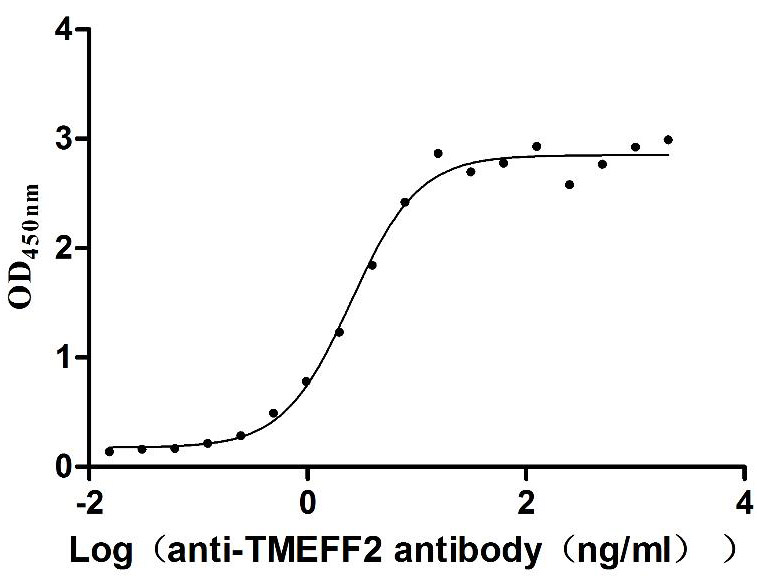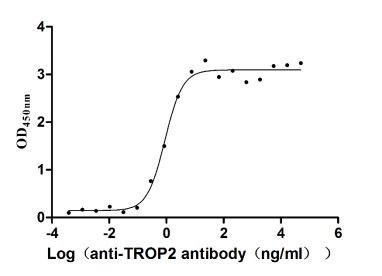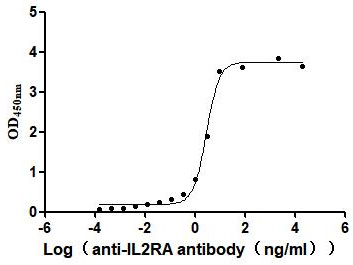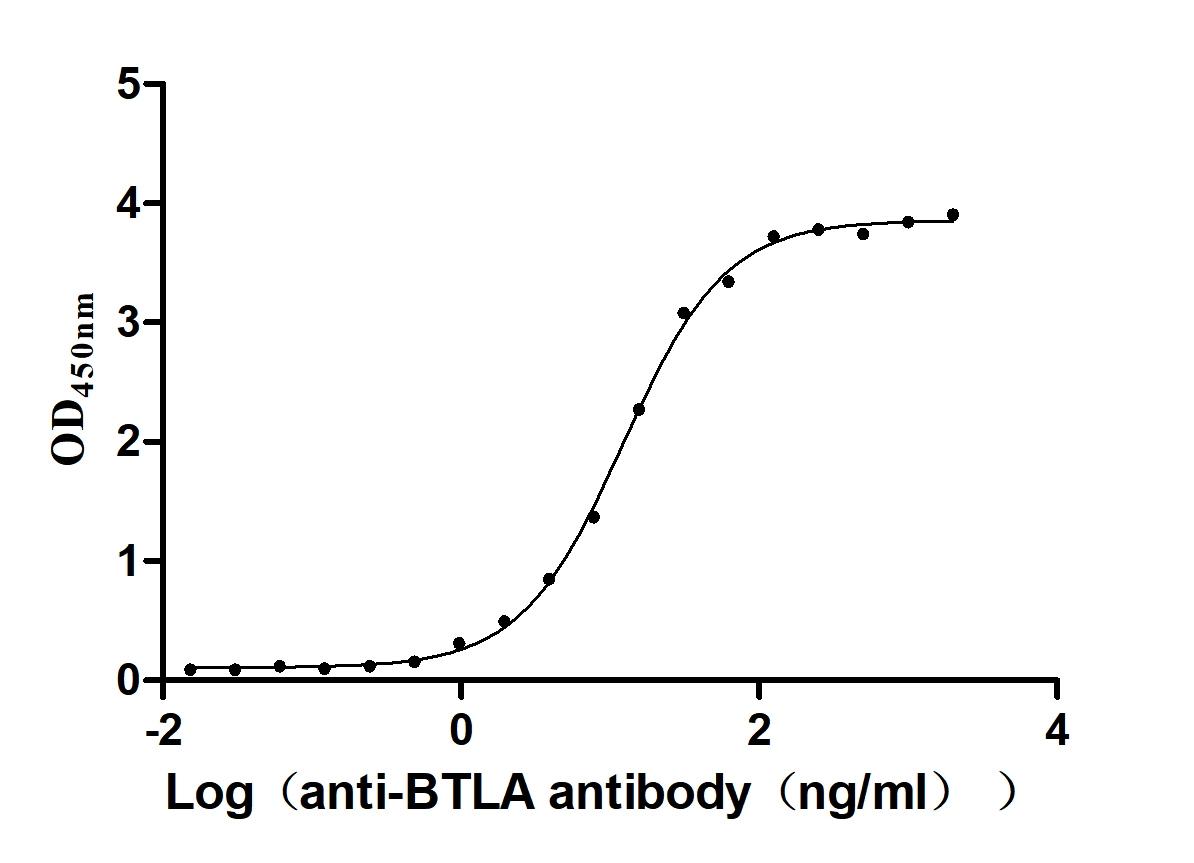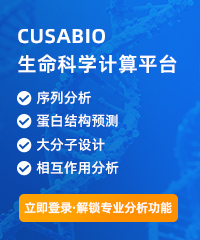Recombinant Human Dual specificity mitogen-activated protein kinase kinase 7 (MAP2K7)
-
中文名稱:人MAP2K7重組蛋白
-
貨號:CSB-YP013416HU
-
規格:
-
來源:Yeast
-
其他:
-
中文名稱:人MAP2K7重組蛋白
-
貨號:CSB-EP013416HU
-
規格:
-
來源:E.coli
-
其他:
-
中文名稱:人MAP2K7重組蛋白
-
貨號:CSB-EP013416HU-B
-
規格:
-
來源:E.coli
-
共軛:Avi-tag Biotinylated
E. coli biotin ligase (BirA) is highly specific in covalently attaching biotin to the 15 amino acid AviTag peptide. This recombinant protein was biotinylated in vivo by AviTag-BirA technology, which method is BriA catalyzes amide linkage between the biotin and the specific lysine of the AviTag.
-
其他:
-
中文名稱:人MAP2K7重組蛋白
-
貨號:CSB-BP013416HU
-
規格:
-
來源:Baculovirus
-
其他:
-
中文名稱:人MAP2K7重組蛋白
-
貨號:CSB-MP013416HU
-
規格:
-
來源:Mammalian cell
-
其他:
產品詳情
-
純度:>85% (SDS-PAGE)
-
基因名:
-
Uniprot No.:
-
別名:c-Jun N-terminal kinase kinase 2; Dual specificity mitogen activated protein kinase kinase 7; Dual specificity mitogen-activated protein kinase kinase 7; JNK activating kinase 2; JNK kinase 2; JNK-activating kinase 2; JNKK 2; Jnkk-2; Jnkk2; MAP kinase kinase 7; MAP2K7; MAPK/ERK kinase 7; MAPKK 7; MAPKK-7; MAPKK7; MEK 7; Mitogen Activated Protein Kinase kinase 7; MKK 7; MKK-7; MKK7; MP2K7_HUMAN; PRKMK 7; PRKMK-7; PRKMK7; SAPK kinase 4; SAPKK-4; SAPKK4; Sek 2; Sek-2; Sek2; SKK4; stress-activated protein kinase kinase 4
-
種屬:Homo sapiens (Human)
-
蛋白長度:Full Length of Mature Protein
-
表達區域:2-419
-
氨基酸序列AASSLEQKL SRLEAKLKQE NREARRRIDL NLDISPQRPR PTLQLPLAND GGSRSPSSES SPQHPTPPAR PRHMLGLPST LFTPRSMESI EIDQKLQEIM KQTGYLTIGG QRYQAEINDL ENLGEMGSGT CGQVWKMRFR KTGHVIAVKQ MRRSGNKEEN KRILMDLDVV LKSHDCPYIV QCFGTFITNT DVFIAMELMG TCAEKLKKRM QGPIPERILG KMTVAIVKAL YYLKEKHGVI HRDVKPSNIL LDERGQIKLC DFGISGRLVD SKAKTRSAGC AAYMAPERID PPDPTKPDYD IRADVWSLGI SLVELATGQF PYKNCKTDFE VLTKVLQEEP PLLPGHMGFS GDFQSFVKDC LTKDHRKRPK YNKLLEHSFI KRYETLEVDV ASWFKDVMAK TESPRTSGVL SQPHLPFFR
-
蛋白標簽:Tag?type?will?be?determined?during?the?manufacturing?process.
The tag type will be determined during production process. If you have specified tag type, please tell us and we will develop the specified tag preferentially. -
產品提供形式:Lyophilized powder
Note: We will preferentially ship the format that we have in stock, however, if you have any special requirement for the format, please remark your requirement when placing the order, we will prepare according to your demand. -
復溶:We recommend that this vial be briefly centrifuged prior to opening to bring the contents to the bottom. Please reconstitute protein in deionized sterile water to a concentration of 0.1-1.0 mg/mL.We recommend to add 5-50% of glycerol (final concentration) and aliquot for long-term storage at -20℃/-80℃. Our default final concentration of glycerol is 50%. Customers could use it as reference.
-
儲存條件:Store at -20°C/-80°C upon receipt, aliquoting is necessary for mutiple use. Avoid repeated freeze-thaw cycles.
-
保質期:The shelf life is related to many factors, storage state, buffer ingredients, storage temperature and the stability of the protein itself.
Generally, the shelf life of liquid form is 6 months at -20°C/-80°C. The shelf life of lyophilized form is 12 months at -20°C/-80°C. -
貨期:Delivery time may differ from different purchasing way or location, please kindly consult your local distributors for specific delivery time.Note: All of our proteins are default shipped with normal blue ice packs, if you request to ship with dry ice, please communicate with us in advance and extra fees will be charged.
-
注意事項:Repeated freezing and thawing is not recommended. Store working aliquots at 4°C for up to one week.
-
Datasheet :Please contact us to get it.
相關產品
靶點詳情
-
功能:Dual specificity protein kinase which acts as an essential component of the MAP kinase signal transduction pathway. Essential component of the stress-activated protein kinase/c-Jun N-terminal kinase (SAP/JNK) signaling pathway. With MAP2K4/MKK4, is the one of the only known kinase to directly activate the stress-activated protein kinase/c-Jun N-terminal kinases MAPK8/JNK1, MAPK9/JNK2 and MAPK10/JNK3. MAP2K4/MKK4 and MAP2K7/MKK7 both activate the JNKs by phosphorylation, but they differ in their preference for the phosphorylation site in the Thr-Pro-Tyr motif. MAP2K4/MKK4 shows preference for phosphorylation of the Tyr residue and MAP2K7/MKK7 for the Thr residue. The monophosphorylation of JNKs on the Thr residue is sufficient to increase JNK activity indicating that MAP2K7/MKK7 is important to trigger JNK activity, while the additional phosphorylation of the Tyr residue by MAP2K4/MKK4 ensures optimal JNK activation. Has a specific role in JNK signal transduction pathway activated by proinflammatory cytokines. The MKK/JNK signaling pathway is also involved in mitochondrial death signaling pathway, including the release cytochrome c, leading to apoptosis. Part of a non-canonical MAPK signaling pathway, composed of the upstream MAP3K12 kinase and downstream MAP kinases MAPK1/ERK2 and MAPK3/ERK1, that enhances the AP-1-mediated transcription of APP in response to APOE.
-
基因功能參考文獻:
- The assessment of the interaction between GADD45beta and MKK7 and the elucidation of the recognition surfaces between DTP3 and MKK7 significantly advance the understanding of the mechanism underlying the inhibition of the GADD45beta/MKK7 interaction by DTP3 and pave the way to the design of small-molecule DTP3 analogues. PMID: 29572137
- In the coBRIM phase III trial, the addition of cobimetinib, an MEK inhibitor, to vemurafenib, a BRAF inhibitor, significantly improved progression-free survival [hazard ratio (HR), 0.58; P < 0.0001] and overall survival (HR, 0.70; P = 0.005) in advanced BRAF-mutated melanoma. Here, we report on the incidence, course, and management of key adverse events (AEs) in the coBRIM study PMID: 28444112
- the p.Glu116Lys rare variant in MAP2K7 predisposes its carriers to develop COPD, which would provide a useful genetic biomarker for COPD susceptibility in Chinese. PMID: 28120412
- Combination BRAF and MEK inhibition has also been shown to improve overall survival in patients with V600E-mutated melanoma. Responses to therapy are often rapid, and treatment is not associated with immune-related adverse events. PMID: 28561662
- The latter insight is likely to promote the production of allosteric MAP2K7 inhibitors. PMID: 28890347
- MEK activation cooperates with Cdkn2a and Pten inactivation to induce melanoma PMID: 28263969
- MKK7 undergoes neddylation in human breast cancer cells PMID: 26364603
- In an Eastern Chinese population, carriers of MAP2K7 rs3679T variant genotypes had an increased risk of NSCLC. PMID: 27861856
- combined pan-RAF and MEK inhibition can overcome intrinsic and acquired resistance to single-agent RAF/MEK inhibition, supporting dual pan-RAF and MEK inhibition as a novel therapeutic strategy for BRAF- and KRAS-mutant cancers PMID: 26351322
- our study suggested that black rice anthocyanins extract suppress metastasis in breast cancer cells by targeting the RAS/RAF/MAPK pathway PMID: 26649302
- Crystal structures of the wild type and C218S mutant of MAP2K7 were determined. Cys218 plays a crucial role in configuring an auto-inhibition form of MAP2K7. PMID: 26987717
- We found that the MKK7 p.Glu116Lys rare polymorphism was significantly associated with lung cancer risk, progression and prognosis PMID: 27028764
- we explored the effects of selumetinib in combination with gefitinib in a panel of TNBC cells, in order to evaluate whether the simultaneous blockade of the EGFR and the RAS/MEK/ERK pathway might increase the antitumor activity of selumetinib in TNBC. PMID: 25959272
- a widespread role for the JNK-CELF2 axis in controlling splicing during T-cell activation, including a specific role in propagating JNK signaling. PMID: 26443849
- This review will focus on the science and clinical findings related to targeted therapies that inhibit BRAF or MEK as well as the immunotherapies that block the CTLA-4 or PD-1 pathways PMID: 25899612
- BCR-ABL promotes PTEN downregulation through a MEK dependent pathway. PMID: 25343485
- In conclusion, the expression of hepatitis B virus core protein sensitized hepatocytes to TNF-alpha-induced apoptosis by disrupting the interaction between MKK7 and RACK1. PMID: 25428880
- Combination of AAG8 antagonist and very low concentration of a MEK inhibitor synergistically restricts the growth of drug-resistant cells. PMID: 24634165
- MKK7 is a major functional target of miR-493, and its suppression thwarts liver metastasis of colon cancer cells. PMID: 24533778
- Gadd45B protects the liver through two entirely different processes: binding MKK7 to block damaging signal transduction or binding CAR to coactivate anabolic transcription. (Review) PMID: 24104474
- the results imply that reduced function of the MAP2K7-c-Jun N-terminal kinase (JNK) signalling cascade may underlie some of the neurochemical changes and core symptoms in schizophrenia. PMID: 22899651
- Overexpressed RACK1 augments JNK activity and thereby promotes hepatocellular carcinoma growth through directly binding to MKK7 and enhancing MKK7 activity. PMID: 22903704
- Taxol induces apoptosis in chronic myelogenous leukemia cells by inducing intracellular oxidative stress and JNK activation pathway. PMID: 21074392
- Alpinetin suppresses proliferation of human hepatoma cells by the activation of MKK7 and elevates sensitization to cis-diammined dichloridoplatium. PMID: 22159816
- a novel function for the stress kinase MKK7 as a regulator of the circadian clock in mammalian cells at steady state. PMID: 22267733
- WDR62 associates directly with the MKK7beta1 isoform independently of JNK binding, but fails to interact with MKK7alpha1. PMID: 21749326
- ML-1 activated a MAP kinase and an extracellular signal-regulated kinase (ERK)1/2 but not p38 or the c-Jun N-terminal kinase (JNK) PMID: 11891214
- JNK, MKK-4, and MKK-7 form an active signaling complex in rheumatoid arthritis and this novel JNK signalsome is activated in response to IL-1 and migrates to the nucleus. PMID: 13130464
- report the cloning of hMKK7gamma1, the human homolog of murine MKK7gamma1 PMID: 16442502
- MKK7 contains three JNK-docking sites that interact to selectively bind JNK and contribute to JNK signal transmission and specificity PMID: 16533805
- data indicate that only MKK-7 is required for JNK activation in fibroblast-like synoviocytes after cytokine stimulation PMID: 16802349
- Association of Gadd45beta with MKK7 involves a network of interactions mediated by its putative helices alpha3 and alpha4 and loops 1 and 2 PMID: 17485467
- p38 MAPK inhibitors SB202190 and SB203580 activated JNK via MLK-3/MKK7 pathway. PMID: 18222647
- The results suggest the occurrence of a large complex containing at least an MKK7-Gadd45 beta:Gadd45 beta-MKK7 tetrameric unit whose complexity could be further increased by the dimeric nature of the isolated MKK7. PMID: 18343408
- Disruption of signaling through MKK7 yields differential response in hypoxic colon cancer cells treated with oxaliplatin. PMID: 18436711
顯示更多
收起更多
-
亞細胞定位:Nucleus. Cytoplasm.
-
蛋白家族:Protein kinase superfamily, STE Ser/Thr protein kinase family, MAP kinase kinase subfamily
-
組織特異性:Ubiquitous; with highest level of expression in skeletal muscle. Isoform 3 is found at low levels in placenta, fetal liver, and skeletal muscle.
-
數據庫鏈接:
Most popular with customers
-
Recombinant Human Tomoregulin-2 (TMEFF2), partial (Active)
Express system: Mammalian cell
Species: Homo sapiens (Human)
-
Recombinant Human Tumor-associated calcium signal transducer 2 (TACSTD2), partial (Active)
Express system: Mammalian cell
Species: Homo sapiens (Human)
-
Recombinant Human Interleukin-2 receptor subunit alpha (IL2RA), partial (Active)
Express system: Mammalian cell
Species: Homo sapiens (Human)
-
Recombinant Human B- and T-lymphocyte attenuator(BTLA), partial (Active)
Express system: Mammalian cell
Species: Homo sapiens (Human)
-
Recombinant Human Interleukin-12 receptor subunit beta-1(IL12RB1),partial (Active)
Express system: Mammalian cell
Species: Homo sapiens (Human)


